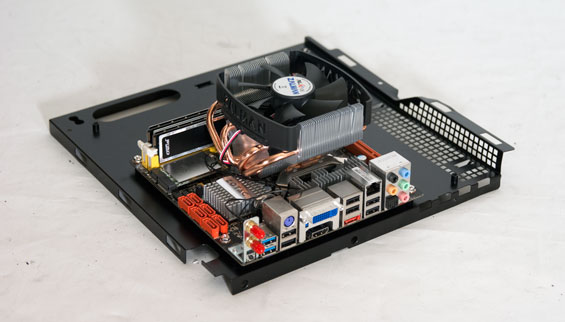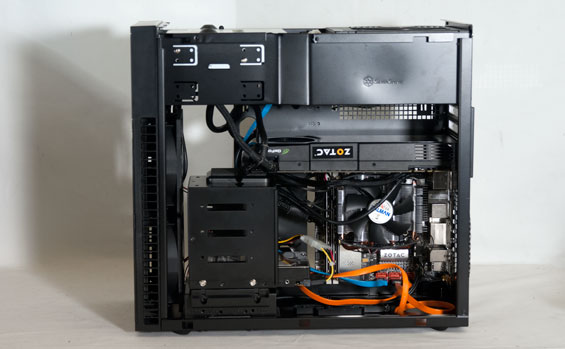SilverStone Precision PS07: Temjin For Less?
by Dustin Sklavos on January 3, 2012 12:20 AM EST- Posted in
- Cases/Cooling/PSUs
- SilverStone
- MicroATX
- Mini-Tower
Assembling the SilverStone Precision PS07
Once again, the SilverStone Precision PS07's assembly was another exercise in deja vu. SilverStone includes an instruction manual that details a very specific way to assemble the enclosure from start to finish to make things as easy as possible, and for the most part it's on the mark. Their cases often feel like puzzles with very specific solutions, and thankfully you don't have to figure them out on your own.

The PS07 comes apart in a few different places. You won't have to remove the front fascia, but the side panels, top panel, motherboard tray, and drive cage all come out. You don't necessarily have to do all of these things, but they can help. SilverStone includes standoffs built into the motherboard tray that makes mounting the board a breeze, but I found locking the tray back into place to be on the awkward side. When I assembled the TJ08-E I opted not to remove the tray to install the board, and that turned out to be the right choice. With the more easily removable drive cage it's simply not necessary.

While ordinarily the power supply is one of the last things I'd install, it pays to pop it into the PS07 early. One of the last things to go in should actually be the optical drive, as you run the risk of dealing with some cable clearance issues in the PS07. Theoretically you can get a 180mm power supply into this enclosure, but honestly you'll want to use a 160mm unit instead like I did for this review build. This is also a situation where using a non-modular power supply may actually be beneficial; there's space behind the motherboard tray to stash excess cables, and modular connections in the PSU can add to the overall length of the unit.

If you're using a tower-style cooler for the CPU heatsink, you'll have to remove the hard drive cage to install 3.5" drives. There's a mount on the bottom of the enclosure for a single 2.5" drive (SSD, naturally), and the ports of the drive line up with the anterior of the motherboard tray nicely, making it reasonably easy to wire. Finally, getting a card like our GeForce GTX 580 in may require some work depending on your motherboard layout, but I found most of the effort involved was the result of our Zotac board packing things in too close to the PCI Express x16 slot.
Given the close quarters of the PS07, the build remains nonetheless surprisingly clean. This isn't the easiest case in the world to assemble, but for its somewhat unusual design there's still a clear logic to how things come together. It's a sharp contrast against some of the Lian Li enclosures I've tested recently, where Lian Li's engineers seem to have their own internal logic they're going to work off of whether the rest of us understand it or not.
















27 Comments
View All Comments
MadMan007 - Tuesday, January 3, 2012 - link
1) Noise levels versus the TJ08-E without a GPU (and especially a top of the like one like the GTX580) may be more representative of the difference between these cases - namely the open fan front panel on the TJ08-E versus the P180-like door and side intakes on the PS07.The noise level of the former changes very little with the GPU, the latter changes quite a bit. This tells me the GPU has more influence on the sound level of the PS07 making it a good candidate for quieter computing for those not looking to use monster GPUs or who might use quieter or even passive GPUs.
2) A reversal in the PSU type recommendation versus the TJ08-E. In the TJ08-E review you said "I also strongly suggest builders use modular power supplies wherever possible and here it might actually be a requirement. There's clearance behind the tray for routing cables, but unfortunately routing everything was just a little bit too fraught, and so our end testing build winds up feeling more cluttered than I'd like and I'm sure more than SilverStone would prefer." but in this review you say to avoid modular PSUs and that there is good space behind the motherboard tray for routing cables.
So which is it? I can see how a modular PSU might actually be worse when it comes to clearance for the optical drive because of modular connectors adding length, but the complete opposite statements and recommendation has me confused. Can you comment please?
Brutalizer - Tuesday, January 3, 2012 - link
Micro-ATX bears to many compromises. I dont want to compromise. I need a ATX case. But the smallest possible ATX case, with just room for a few disks and a decent gaming graphics card. Todays disks are so large, 4TB that you dont need raid anymore. You also dont need the biggest gaming card to get decent performance.MicroATX does not have many expansion ports enough.
What is the smallest ATX case?
aesnt - Tuesday, January 3, 2012 - link
This one's a decent size full ATX tower, but won't fit longer graphics cards:COOLER MASTER Elite 360
17.30" x 5.80" x 14.20" from Newegg
Death666Angel - Tuesday, January 3, 2012 - link
What do you mean by expansion ports? Do you mean PCIe slots? Or SATA/USB? I can find enough mATX boards with 6 or 7 SATA ports, 16 USB ports and SLI/CF capability. Unless you really need 7 PCI(e) slots, I don't see what advantage ATX has for you :-).As for small ATX cases, the smallest I see unfortunately come from mediocre brands:
http://geizhals.de/?cat=gehatx&xf=534_ATX~550_...
and a lot of them get their smallish volume from being quite thin, so you would run into issues with large CPU heatsinks.
Brutalizer - Wednesday, January 4, 2012 - link
I am talking about at 4-5 PCIe slots or so. The mini/micro ITX cases I have seen, have room for 2-3 PCIe slots.I also suspect that when using such a small mobo and case, I must compromise. For instance, I can not any longer buy standard cpu coolers, nor power supplies. I must buy much smaller ones, costing more, and restricting the hardware I can use.
If you know of a small micro/mini ITX with Xeon cpus, ECC RAM, and 4-5 PCIe slots, and a decent graphics card - then I am happy to read more about that model.
somedude1234 - Wednesday, January 4, 2012 - link
Nearly every uATX board I've seen has 4 PCIe slots. MiniITX limits you to a single PCIe slot. Every uATX case I've seen also has room to support a motherboard with 4 PCIe slots. Now, if you're going to be installing a double-width GPU, then you're going to burn two of your slots.If you're looking for a great uATX board for a Xeon server, the SuperMicro X9SCM-F is a good choice. It's based around the C204 chipset for SB Xeons, so you get ECC support. You'll get two PCIe 2.0 x8 and two PCIe 2.0 x4 slots (four total). The "-F" version of the board also gives you an on-board BMC with full IPMI 2.0 support.
For uATX cases, they pretty much all take a standard PSU and offer four PCIe slots, the Antec NSK3480 is a nice choice.
Death666Angel - Friday, January 6, 2012 - link
There is mini ITX (mITX) and then there is micro ATX (mATX/yATX since there is no easy way to type the greek letter on a normal keyboard).mATX mainboards can have 4 PCI(e) slots. If you need 4, you can buy that. If you need 5, you can't.
mATX has no compromises when it comes to PSUs or CPU heatsinks, at least none that are special to it and do not pertain to smaller ATX cases as well. The TJ08-E can fit 180mm PSUs if you can cut off some space from the ODDs (but 160mm, even high powered ones for 2-3 graphics cards do not cost more! :D) and it has enough room to cool any CPU (even overclocked) quite nicely and silently.
Supermicro has a few mATX C204 Xeon Mainboards with 4 PCIe x8 slots. But mainboards do not come with graphics cards.
corrion - Tuesday, January 3, 2012 - link
Take a look at the Antec Solo II, sounds like it's right up your alley.BernardP - Tuesday, January 3, 2012 - link
The lenght of the PS07 is .6 inch more than the TJ08-EDeath666Angel - Tuesday, January 3, 2012 - link
I have the TJ08-E since Christmas and am thoroughly enjoying it!This redesign looks very interesting, it opens up the possibility of getting high end 120mm fans, because 180mm fans are not so wide spread and they seem to have varying degrees of engine noise and other annoying small defects that result in additional noises according to a forum I visit. Although one 180mm can move more air at lower noise in theory.
It also changes support from 200mm radiator to 240mm radiator, again, opening up competition.
The missing external 3.5" bay won't be an issue I wager. I have thought about sticking a card reader in there, but nothing that goes in there will be a big deal if it's missing I think. 2 external 5.25" bay already provide plenty of options, only people with the need to copy DVDs on the fly seem to be stuck. :-)
$20 can give you an additional few GB of RAM or higher clocked RAM or give you a better custom cooled graphics card or a more silent CPU heatsink. If you are on a budget that money can be well spent I think. :-)
On an unrelated note: I would really like to see these gamer (performance) mATX chassis be tested with a more demanding set of components like the regular ATX chassis are. I understand the reason for a standardized test bed and only having 2 instead of 3, but it really is a shame not to be able to compare this or the TJ08-E with bigger chassis. :-)